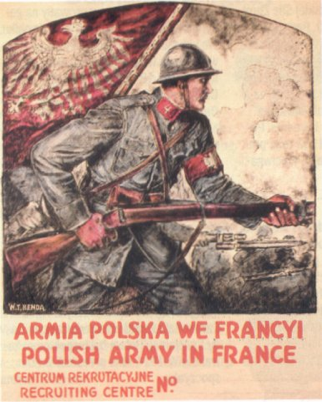Poland’s Army
In 1914, Poland did not have an army. In fact Poland did not exist as a country. What had once been a proud nation had long ago been annexed by Russia on the east, Austria on the south, and Prussia on the west. Living in the United States were Polish immigrants whose culture and language were being threaten in Eastern Europe. These Polish-Americans had long sought a way to bring independence back to their native country and with France and England declaring war against Kaiser Wilhelm II, the Polish people felt it was now the time to form a Polish army. One man stepped forward to lead the fight for Polish independence. His name was Ignacy Paderewski (1860 - 1941); the great Polish pianist, and composer. His name had become synonymous with the highest level of piano virtuosity and his fame grew with each concert.
In 1913, Paderewski settled in the United States and began petitioning President Woodrow Wilson to train a Polish army. At first Wilson hesitated, not wanting to be brought into the war in Europe. However, Wilson did allow an army training camp, called Camp Kosciusko, to be established on Canadian soil at Niagara-on-the-Lake, Ontario. Some 20,000 Polish immigrants from North America heeded the call of their homeland and volunteered to fight in the Polish Army in France (Armia Polska We Francji). These recruits from America were combined with volunteers from other places like South America. Together they comprised the first free Polish Army since General Henryk Dabrowski and the Polish Legions fought under Napoleon back in the late 1790’s.

1917 Army Recruiting Poster
This new army was known as the "Blue Army" for the blue French uniforms they wore. They fought on a number of French battlefields in the late stages of the war. When the war was over 100,000 Polish soldiers were transported across Germany to Warsaw. There they were instrumental in helping to win the Polish-Soviet war of 1919-1920, cementing Poland's independence until Hitler’s invasion 19 years later.
Due to the passing of time this story of WWI is barely known. I first became aware of the formation of the Polish Blue Army while visiting Niagara-on-the-Lake this past summer. Located in a corner of a local church cemetery are 22 graves of Polish recruits who died of influenza while training at Camp Koscuisko. These graves are surrounded by an iron fence and at the gate is a bronze plaque giving details of the formation of the Blue Army in Canada and of its service in France. Various Polish organizations faithfully decorate these soldiers’ graves each year to commemorate the memory of these freedom fighters who fought and died for their homeland - Poland.
